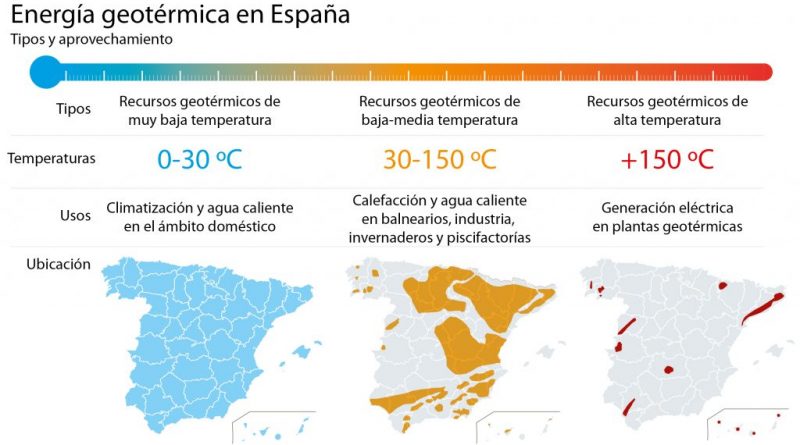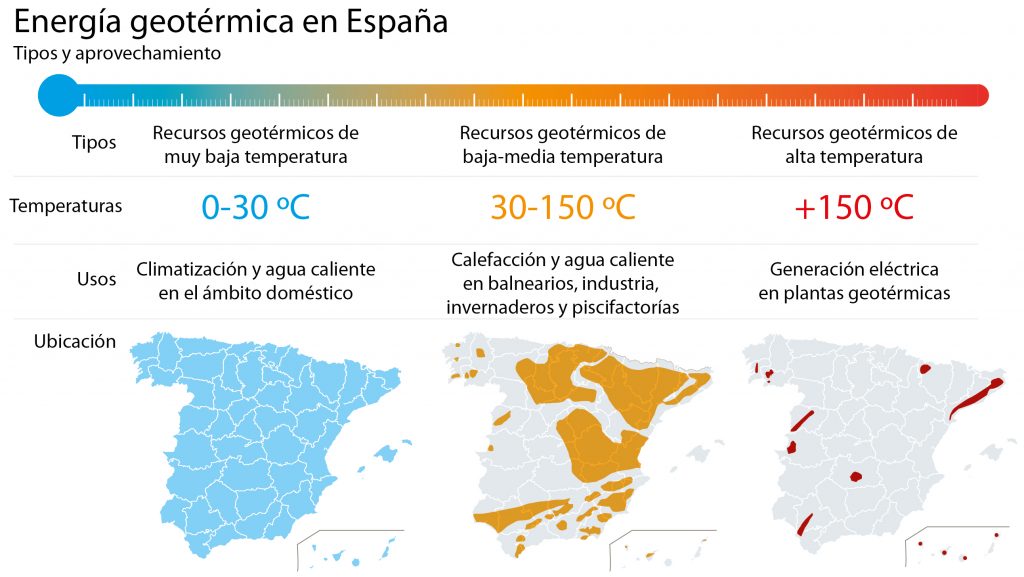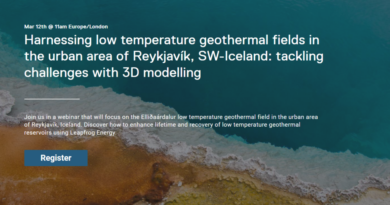Geothermal energy – forgotten treasure of Spain
Energy Disrupter
The lack of knowledge about it, its high initial cost or lack of unified regulation slows the take off of geothermal energy in Spain.
Like in other countries geothermal energy is a valuable resource in Spain and if further developed, could create thousands of new jobs and help advance the long-awaited decarbonization of the economy.
There is work ahead. “In Spain it is the largely forgotten and the most unknown by administrations, public bodies and technicians, while in the rest of Europe it is a consolidated technology . In Sweden and Switzerland, for example, it has been very mature for more than 20 years”, explains Daniel Munoz , Geothermal director at Sacyr Ingeniería e Infraestructuras.
But not all geothermal resources are the same. Those of high temperature (over 150º), which are several kilometers below the surface, are used mainly to generate electrical energy. “The degree of implementation is nil, although it has been known since the 1980s that the country has a very high potential, especially in the Canary Islands and Catalonia. There is a lack of state investment in geothermal exploration and research, geological risk mitigation mechanisms as other countries such as France or Germany have, or a rate regulation for this source ”, points out Albert Pujadas , Coordinator of the Geothermal Working Group of the Cluster de l ‘ Efficient Energy of Catalonia (CEEC).
Those of medium-low temperature (30-150º), which provide heating and hot water in cities, spas, industry, greenhouses or fish farms, are not widely used within our borders, where the exploitation of very low resources is more frequent. enthalpy or shallow (less than 30º), suitable for heating, cooling and sanitary hot water in buildings and homes. To do this, some holes are made, some collectors are buried that extract heat from the ground and with a heat pump (located inside the property) they transmit it to the house in winter through underfloor heating or fan coils, while in summer it is it keeps cool as heat is transferred to the ground through those same collectors.
Despite the fact that they exist practically in the entire national geography, ” penetration in Europe is being much higher than in Spain “, as Margarita de Gregorio , director of Geothermal at APPA, the employer’s association for renewables, and coordinator of the Spanish Geothermal Technology Platform (Geoplat).
The delay is explained, in part, because “this energy source started developing only in heating and in Spain the demands are not as high as in other places on the continent, but since it has been shown that it can also be applied in cooling it is being implemented more and more , although the Nordic countries are ahead of us “, says Teresa Magraner , professor in the department of applied thermodynamics at the Polytechnic University of Valencia (UPV) and an expert in geothermal energy.
It is difficult to quantify the number of installations in our country since there is no official record of renewable thermal energy. According to the EurObserv’ER barometer, 198 geothermal heat pumps were sold in Spain in 2019 compared to 25,343 in Sweden , 19,000 in Germany or 12,112 in the Netherlands. The Institute for Energy Diversification and Saving (IDAE), for its part, puts 211 installations in 2019. But Ecoforest, the only Spanish manufacturer of geothermal heat pumps, tells this newspaper that 667 units were sold that year. “As there is no official record, they are not included and worst of all, this renewable generation does not count towards the objectives that Spain has committed to before the European Commission”, warns De Gregorio.
He considers that there are several factors that limit the growth of this energy: “The technologies are highly controlled, mature, efficient and competitive, but the fact that you have to drill is a brake”. Another obstacle is regulatory . «There is no specific regulation. Each autonomous community has its own or it does not, which makes it very difficult to process an installation, “he laments. And he also lacks greater institutional support : “The same political will that exists for the promotion of electric renewables should exist for thermal renewables.”
Nor does the high initial investment help . It costs about EUR 18,000 euros for a 150-square-meter single-family home. The experts emphasize, of course, that the amortization is about six years and the useful life of the facilities is usually high, up to 50 years. Energy savings, which can reach up to 70%, are another lure . “In cold generation, one kilowatt of electricity produces six kilowatts of refrigeration, there are no technologies that reach those efficiencies”, recalls Munoz.
The residential sector , especially single-family homes and cooperative buildings, is the one in which it has gained the most followers, without forgetting offices, shopping centers or hospitals. “Although Spain is still one of the European countries with the lowest installed thermal power, according to the latest report from the European Geothermal Energy Council for 2019, it is the country that, comparing the 2018 data, has the highest growth rate, standing at 20 % ”, Recalls Pujadas. Ecoforest accounts for “green shoots”. In 2019, the sale of geothermal heat pumps increased by 50% year-on-year and in 2018 the increase was 62% compared to the previous year.
Opportunities
“In the short-medium term, geothermal energy will enter the pie of the energies that make up air conditioning in a much higher percentage than it currently has, I trust that it will be one of the recommendations set by the EU for the Spanish energy system. Anything that is diversifying as has been done in electricity production results in numerous advantages such as industrial impulse or non-dependence on external energies “, says Arturo Farfán , principal investigator of the Geo-District 3.0 project.
With the European recovery funds, Spain faces its last trick to bet decisively on this energy source. The opportunities that would open up are not negligible . “The entire geothermal value chain could be built in Spain. The resource is very local, the installers too, and the technology should be. We could close the circles and generate employment both in the industry and in the installation, all of proximity, and that is what we want to happen between now and 2030 “, says De Gregorio.
Initiatives that lead the way
Different geothermal projects have been successfully carried out in Spain. The largest installation is in the Sant Pau Hospital (Barcelona). “There are different teams, but they all capture energy from the ground through geothermal energy and there is no support from other solutions,” says Daniel Munoz, Geothermal Director of Sacyr Ingeniería e Infraestructuras, the company that carried out the installation.
Another initiative has been developed in Ifema, which has been operating a geothermal plant since the beginning of 2018 that supplies the base demand for air conditioning in the central office building from the use of energy from the very low temperature subsoil. «It is a clear commitment of Ifema in line with the promotion of renewables, necessary for the objective of reducing CO2 emissions. The reduction in 2019 was close to 150 tons “, points out Javier Martín , director of the Technical Area of ??Ifema.
Source: ABC Economica

















